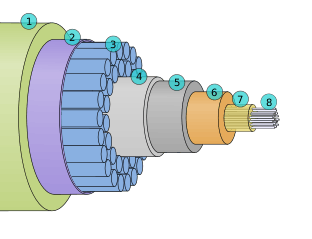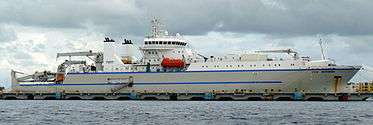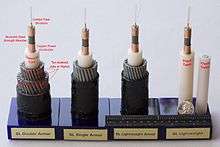International Cable Protection Committee
International Cable Protection Committee (ICPC) | |
|---|---|
 Logo
| |
Motto: Sharing the Seabed in Harmony with Others | |
| Headquarters | United Kingdom |
| Membership | More than 160 Members from over 60 countries |
• | 22 May 1958 |
Website www | |
Introduction
The International Cable Protection Committee was formed in 1958 and its primary goal is to promote the safeguarding of international submarine cables against man-made and natural hazards. The organisation provides a forum for the exchange of technical, legal and environmental information about submarine cables and, with more than 155 members from over 60 nations, including cable operators, owners, manufacturers, industry service providers, as well as governments, it is the world's premier submarine cable organization.
Nearly 100% of the world's intercontinental electronic communications traffic is carried by the undersea cable infrastructure.[1] Likewise, submarine power cables underpin the global expansion of offshore renewable energy generation. As such, the impact of failures of these critical telecommunications and power cables can be devastating to social and economic stability. This is why submarine cables are classified as "critical infrastructure" that is to be protected from physical damage due to manmade or natural causes.[2]

1 – Polyethylene
2 – Mylar tape
3 – Stranded steel wires
4 – Aluminium water barrier
5 – Polycarbonate
6 – Copper or aluminium tube
7 – Petroleum jelly
8 – Optical fibers
Prime Activities of the ICPC
The prime activities of the International Cable Protection Committee (ICPC) are related to promoting the awareness of submarine cables, both telecom and power, as critical infrastructure that must be protected, particularly to other seabed users, governments, and the public by establishing internationally agreed upon standards for cable installation, protection, and maintenance. The ICPC actively monitors the evolution of international treaties and national legislation and help to ensure that submarine cable interests are fully understood and protected by all relevant stakeholders. ICPC supports peer-reviewed research into the interactions of cables with the ocean environment to provide an evidence-based foundation for those interactions.[3]
History
The Cable Damage Committee was established on May 22, 1958. The name of the committee was later changed to the International Cable Protection Committee (ICPC) in 1967 to better reflect that intended aims of the organisation and its membership.[4] The original organisation was for the "Main Committee", as it was originally known, to formulate the policies, which a small Sub-Committee of members, voted in at each Main Committee meeting. Adopted policies were then organised and subsequently implemented. In addition, the Sub-Committee ran the internal administration of the organisation through the secretary.
In the early years, the Sub-Committee would meet frequently, organising many aspects, such as Cable Warning Charts, which were later devolved down to the organisation of individual members. Most of the detailed notes from these early meetings have disappeared prior to 1975, but they always produced a formal report to the Main Committee. The frequency of the meetings prevents their listing prior to the formation of the Executive Committee in 1977.
The title "Plenary" for the Main Committee first appeared in 1972, but would not appear to have been a firm change, but rather a title that evolved gradually during the 1970s. By contrast, the title "Executive" for the Sub-Committee was a firm decision of the 1977 Plenary meeting.
The offices of chairman and vice chairman have been held by the member administration rather than the individual person. This enables a reorganization of staff to take place within an administration, without effecting the committee's organisation. Before 1976 there was no vice chairman, and if the administration holding the chair was unable to attend, as occurred twice, then a chairman had to be nominated at the start of the meeting. After 1976 the absence of the chairman was more smoothly covered, as occurred in 1979 and 1991.
The secretary was initially provided by Cable & Wireless, and subsequently changed to the British Post Office in 1960, although for a number of years after that, the official address remained with Cable & Wireless. The secretariat remained with BPO/British Telecom International continuously until 1990, when an independent secretary was engaged. This was followed later by appointment of an International Cable Legal Advisor (1999) and Marine Environmental Advisor (2003).
Presently, governance is exercised by the ICPC Limited, which operates through a 17-member executive committee elected by the ICPC membership. ICPC membership has expanded and since 2011, national governments have been allowed to join as a government member in its own right. Government members include the Australia, Malta, New Zealand, Singapore, and the United Kingdom. Since February 2013, Associate membership has been made available to any person or group that shares the goals of the ICPC.
Membership
As of March 2017, the ICPC has more than 155 Members from over 60 countries. The membership includes cable owners, operators and manufacturers as well as survey companies, research groups, industry service providers and national governments, and it is the world's premier submarine cable organisation.
Response to change
Numerous changes and associated challenges that affect submarine cables are actively studied and addressed by the ICPC membership through the development of industry recommendations. These recommendations contain the combined knowledge of the ICPC membership such that submarine cables are best protected thus ensuring the utmost in reliability of this critical undersea infrastructure. Some of the changes that are actively monitored by the ICPC are summarized below.
- Rapid development of offshore renewable energy
- Increased incidence of damage caused by shipping
- Seabed becoming crowded in some areas
- Environment responses to climate change particularly regarding natural hazards [4]
- Need to maintain harmony with other seabed users
- Need to ensure harmony with seabed environment [2]
- Need to improve security of submarine cables
Industry recommendations development
The ICPC develops and maintains a suite of industry standards targeted at the various lifespan stages of undersea cables, from conception to retirement. These standards are available to organisations involved with these various stages through ICPC membership.

- Route planning
- Installation
- Operation
- Maintenance
- Protection
- Out of Service
Educational resources
The ICPC provides educational materials for the benefit of those who need to be informed about submarine cables and their role as critical infrastructure.[2][4] These materials are intended to promote the awareness of the strategic, socio-economic, and social benefits of submarine cables, especially to government agencies, the fishing industry, other seabed users and the public. Relevant information is also provided to prospective new submarine cable owners to encourage the adoption of minimum industry standards for the benefit of all involved with the seabed. The ICPC has also entered into memorandums of understanding with the International Seabed Authority and the Rhodes Academy to further cooperation with these two bodies. The ICPC also has a working relationship with the East-West Institute.
Information sharing
The ICPC provides a forum for members to interact and learn about legal, technical, and environmental developments relevant to submarine cables where areas of common interest are identified such that members can benefit from working together and each other's expertise and real-world experience. To ensure information sharing external to the ICPC, affiliations are also developed with equivalent seabed user organisations the world over. Formal relationships with appropriate international organisations are also developed with the goal of information sharing.
Projects
The ICPC engages in projects that are beneficial to the protection of submarine cable systems. For example, a global database showing fault causes and average repair times is developed and maintained. Research projects associated with the potential effects of submarine cables on the seabed environment are also performed to ensure harmony with the undersea environment.[2]
Law
The ICPC actively monitors the development of international treaties and national legislation to advise and support committee members when changes to laws are proposed that may affect submarine cables. Expertise to ensure ongoing compatibility and uniformity of the law with various industry requirements is also provided through ICPC membership.
Workshops are held by the ICPC with national governments and regional organisations to foster understanding of the rights and obligations that States have with respect to submarine cables under the United Nations Law of the Sea Convention (UNCLOS).
The ICPC sponsors a reference handbook based on unique collaboration of 15 industry experts, scientists, and international law scholars that address critical legal and governance issues, as it pertains to submarine cables deployed around the world.[5]
Submarine Telecommunication Cables and the Marine Environment
The interaction between submarine cables and the marine environment is documented in peer-reviewed, mainstream publications.[2][3][6][7] The ICPC supports such research as a means of providing evidence-based analyses to assist cable protection in naturally hazardous regions [3] and cable operations in environmentally sensitive areas. Briefly, cable/environmental interactions can be summarized as follows.

Deep Ocean (greater than 2000 meters)
Over 80% of trans-oceanic telecommunication cables are located in water depths >2000m. There, the risks posed by fishing and shipping – the main causes of cable damage – are small. Accordingly, a typical cable is a 17-22mm diameter tube, the size of a domestic garden hose. It is composed of optical glass fibres, a copper power conductor and steel wires to add strength, all of which are encased in chemically inert, marine-grade polyethylene.[8][9] Antifouling agents are not used. Furthermore, the amount of power in a cable is small being around 0.6 to 1 ampere, which is less than a laptop computer. Deep-ocean cables are laid on the seabed surface with minimal disturbance to the benthic environment.
Laying is planned as a one-off operation in the 20-25 year life of a cable (note the operational life may extend to 30 or more years as improved signal processing has expanded the carrying capacity of some existing cables). Given their well proven design and low risk from deep ocean hazards, cables are subject to an average of 4 faults annually worldwide.[10] However, fault numbers may spike under extreme events such as a major submarine landslide (see Natural Hazards).
While studies of cables and their interaction with deep-ocean organisms are few, independent research from the continental shelf (0-130m average water depth) and the upper continental slope down to around 1200m,[11][12][13][14] reveals little effect of modern cables on animals living on and under the seabed. No statistical differences have been observed regarding the abundance, composition and diversity of organisms living near and distant from cables. Any observed changes are usually within the natural variability of the animals studied.
Continental Margin (less than 2000 meters)
Aptly phrased the "urban sea", this sector of the ocean is the focus of a wide range of human activities that include fishing, mineral exploration, shipping, dredging, renewable energy generation, scientific research as well as telecommunications. As a result, special measures are required to protect cables. This includes (i) strengthening with steel wire armour, which increases cable diameter up to ~50mm, (ii) burial beneath the seabed[8][9] and positive engagement with other seabed users to share information and knowledge regarding their respective industries.
Natural Hazards
Most cable faults result from human activities especially ships' anchoring and commercial fishing that involves contact with the seabed, e.g. bottom trawling.[8][9] Collectively, these activities account for over 65% of cable faults and occur primarily in water depths <200m.[15][16] Damage resulting from natural phenomena account for around <10% of all cable faults, but this percentage can spike during a major event such as large earthquakes (>M=7.0) when multiple cables can break.[17][18][19] On the continental shelf, waves and currents, especially those generated by storms, may abrade exposed cables and/or cause them to sway in the oscillating currents thus inducing fatigue. Those effects are minimized by cable armouring and burial beneath the seabed. Less frequent but nonetheless devastating are tsunami such as the 2011 Great Tohuku Earthquake of 2011 that severely damaged Japanese coastal infrastructure. Such earthquakes may also generate submarine landslides and turbidity currents – sediment-laden currents that travel long distances (100s to 1000s kilometres) at high speeds (up to 68 kilometres/hour). These turbulent flows break cables in water depths down to 5000m and deeper.[17][18][19] For example, offshore Taiwan and Algeria suffered earthquakes in 2006 and 2003 that caused 22 and 29 cable breaks respectively. Turbidity currents also form under major rain storms. The discharged flood waters are so laden with mud and sand that they sink to the seabed and move downslope to form cable-damaging turbidity currents.[20][21] Other natural causes of cable faults include deep-ocean currents, volcanoes and ice. While such forces may be locally significant, worldwide they are minor compared to earthquakes and storms.
External links
| Wikimedia Commons has media related to Maps of submarine communication cables. |
- Official website
- TeleGeography Interactive Cable Map – comprehensive online submarine cable map with a wealth of information.
References
- IEEE, "Reliability of Global Undersea Communications Cable Infrastructure (ROGUCCI) Report, p 33, Issue 1", IEEE, February 2010
- Biodiversity Series 31, "Submarine Cables and the Oceans – Connecting the World", p. 64, ISBN 978-0-9563387-2-3, ICPC/UNEP-WCMC January 2009
- L. Carter, J. D. Milliman, P. J. Talling, R. Gavey, R. B. Wynn, "Near-Synchronous and Delayed Initiation of Long Run-Out Submarine Sediment Flows from a Record-Breaking River Flood, Offshore Taiwan", Geophysical Research Letters, p. 39, L12603, doi:10.1029/2012GL051172, 2012
- "International Cable Protection Committee (ICPC)"
- D.R. Burnett, R. Beckman, and T. Davenport, "Submarine Cables the Handbook of Law and Policy", ICPC and the National University of Singapore – Centre for International Law, 2014
- M.P. Wood, L. Carter, "Whale Entanglements with Submarine Telecommunication Cables", Issue 33, pp. 445–460, IEEE Journal of Oceanic Engineering, 2008
- R. Gavey, "An Evaluation of Modern Hyperpycnal Processes and their Relevance to the Geological Record", p. 339, Southampton University, United Kingdom, 2011
- Burnett, D.R., Beckman, R.C. and Davenport, T.M. eds. Submarine Cables: the Handbook of Law and Policy. Martinus Nijhof Publishers. Chapter 10 pp. 237‑254. ISBN 9789004260320
- Carter, L., Burnett, D., Drew, S., Hagadorn, L., Marle, G., Bartlett‑McNeil, D., Irvine, N., 2009. Submarine Cables and the Oceans‑ connecting the world. UNEP‑WCMC Biodiversity Series 31. ICPC/UNEP/UNEP‑WCMC, 64pp. ISBN 9780956338723, https://www.iscpc.org/publications/
- Palmer‑Felgate, Andy, Nigel Irvine, Simon Ratcliffe and Seng Sui Bah, 2013. Marine Maintenance in the Zones – a Global Comparison of Repair Commencement Times. http://www.suboptic.org/document/marine‑maintenance‑in‑the‑zones‑a‑global‑comparison‑of‑repair‑commencement‑times/%5B%5D
- Grannis, B.M., 2001. Impacts of mobile fishing gear and a buried fibre‑optic cable on soft‑sediment benthic community structure. M.Sc. thesis, University of Maine, 100 pp
- Kogan, I., Paull, C., Kuhnz, L., Burton, E., Von Thun, S., Greene, H.G., and Barry, J., 2006. ATOC/Pioneer Seamount cable after 8 years on the seafloor: observations, environmental impact. Continental Shelf Research 26, 771‑787
- 1. Kuhnz, L. et al., 2015. Potential impact of the Monterey Accelerated Research System (MARS) cable on the seabed and benthic faunal assemblages. MARS Biological Survey Report 33pp plus appendices. https://www.mbari.org/wp‑content/uploads/2016/02/MBARI‑Potential‑impacts‑of‑the‑Monterey‑Accelerated‑Research‑System‑2015.pdf%5B%5D
- Andrulewicz, E., Napierska, D. and Otremba, Z., 2003. The environmental effects of the installation and functioning of the submarine SwePol Link HVDC transmission line: A case study of the Polish Marine Area of the Baltic Sea. Journal of Sea Research 49, 337–345
- Drew, S., 2009. Submarine cables and other activities. in Carter, L., Burnett, D., Drew, S., Hagadorn, L., Marle, G., Bartlett‑McNeil, D., Irvine, N., 2009. Submarine Cables and the Oceans‑ connecting the world. UNEP‑WCMC Biodiversity Series 31. ICPC/UNEP/UNEP‑WCMC, 64pp. ISBN 9780956338723
- Wood, M.P. and Carter, L., 2008. Whale Entanglements with Submarine Telecommunication Cables IEEE Journal of Oceanic Engineering 33, 445‑460
- Carter, L., R. Gavey, P.J. Talling and J.T. Liu, 2014. Insights into submarine geohazards from breaks in subsea telecommunication cables. Oceanography 27(2):58–67, doi:10.5670/oceanog.2014.40
- Cattaneo, A., N. Babonneau, G. Ratzov, G. Dan‑Unterseh, K. Yelles, R. Bracène, B. Mercier de Lèpinay, A. Boudiaf and J. Déverchère, 2012. Searching for the seafloor signature of the 21 May 2003 Boumerdès earthquake offshore central Algeria. Natural Hazards Earth System Science 12, 2159–2172
- Heezen, B.C. and Ewing, M., 1952. Turbidity currents and submarine slumps, and the 1929 Grand Banks earthquake. American Journal of Science 250, 849‑873
- Pope, Ed, Talling, P.J. and Carter, L., 2016. Which earthquakes trigger damaging submarine mass Movements: insights from a global record of submarine cable breaks? Marine Geology doi:10.1016/j.margeo.2016.01.009
- Carter, L., J. D. Milliman, P. J. Talling, R. Gavey, and R. B. Wynn, 2012. Near-synchronous and delayed initiation of long run-out submarine sediment flows from a record-breaking river flood, offshore Taiwan. Geophysical Research Letters, 39, L12603, doi:10.1029/2012GL051172